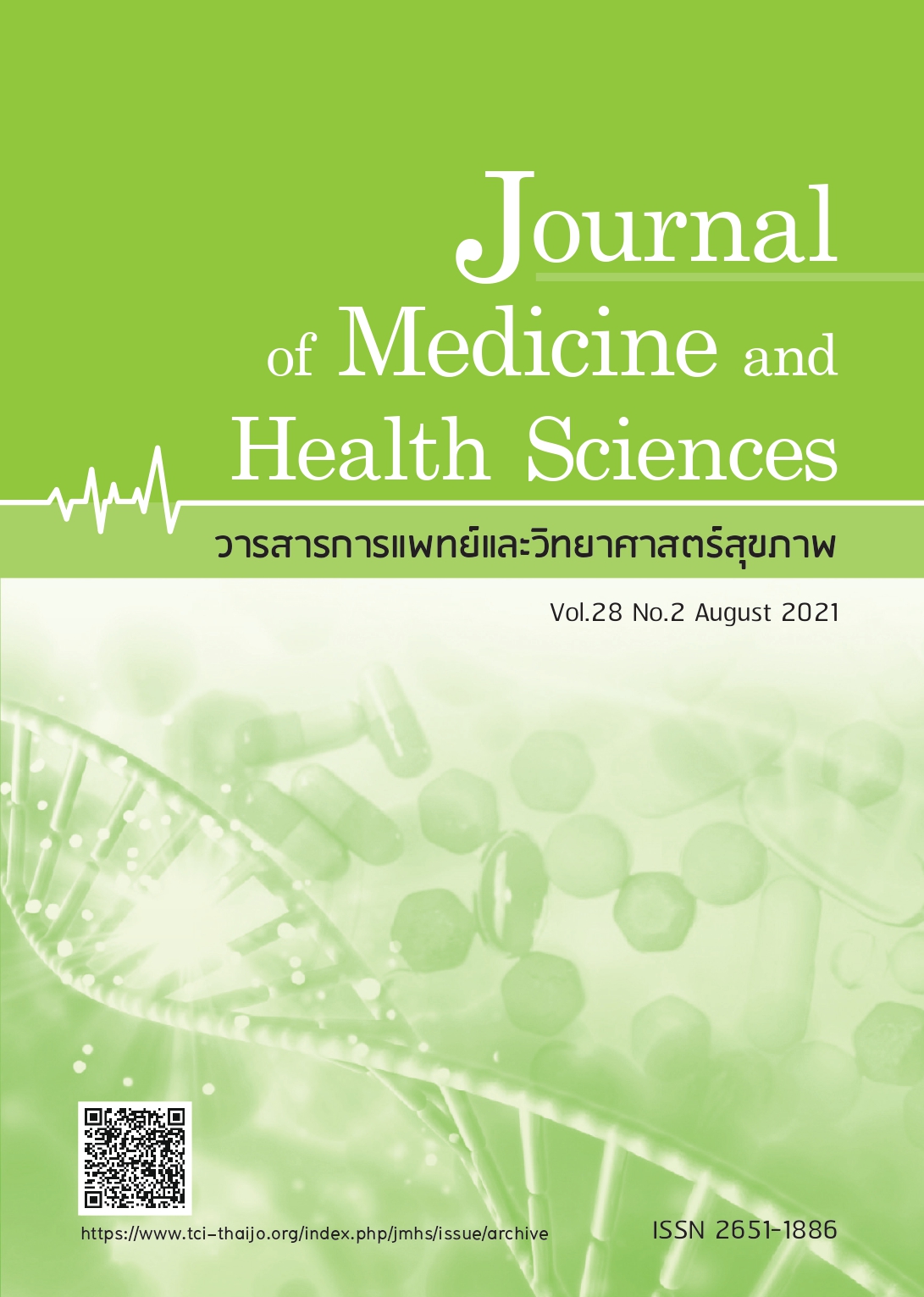Current management of hypertension in chronic kidney disease
Keywords:
anti-hypertensive drugs, chronic kidney disease, guidelines, hypertensionAbstract
A gradual increase in chronic kidney disease (CKD) patients worldwide has been a challenge in terms of health care professionals after optimizing therapy for CKD. One of the key strategies of CKD management is to delay the progression of kidney disease, as well as reducing the risk factors for cardiovascular disease (CVD). Hypertension is a significant factor for both CKD progression and CVD. Therefore, taking care of blood pressure should be emphasized to all CKD patients. The proper measurement of blood pressure (BP) has been important for the diagnosis, evaluation, and follow-up on patients with hypertension. The Office Blood Pressure Monitoring (OBPM) has been widely used in clinical practice. Ambulatory blood pressure monitoring (ABPM) and home blood pressure monitoring (HBPM) have been an alternative BP measurement for selected patients. As many guidelines have set OBPM as a target for blood pressure, patients who measured their blood pressure by ABPM or HBPM, which should be reconsidered to individually determine optimal blood pressure. Several published guidelines on hypertension in CKD have been updated with considering the recent evidence from clinical studies. The target of blood pressure depended on various factors, such as the staging of CKD, albuminuria levels and other comorbidities. Almost all of the guidelines for CKD patients have been consistent with a target BP of 130/80 mmHg or lower. Furthermore, renin angiotensin aldosterone system (RAAS) blockers, including ACEIs/ARBs have been recommended in a wide range of patients with kidney diseases, particularly in those with albuminuria. Although acute kidney injury and hyperkalemia should be warranted in patients taking ACEIs/ARBs, other potential factors of those adverse effects should be intensively excluded before reducing the dose or discontinuing the drugs. Therefore, recommending CEIs/ARBs to CKD to patients who tended to benefit from blocking RAAS mechanisms should be encouraged. The selection of other anti-hypertensive medications should be considered based on the comorbidities of the students, adverse effects, important drug interactions, and clinical outcomes from CKD studies.
References
2. Thai Hypertension Society. 2019 Thai guidelines on the treatment of hypertension. Trickthink: Thai Hypertension Society; 2019.
3. Ong-Ajyooth L, Vareesangthip K, Khonputsa P, et al. Prevalence of chronic kidney disease in Thai adults: a national health survey. BMC nephrol 2009;10:35.
4. Ku E, Lee BJ, Wei J, et al. Hypertension in CKD: Core Curriculum 2019. Am J Kidney Dis 2019;74:120-31.
5. The American College of Cardiology and the American Heart Association. 2017 ACC/AHA/AAPA/ABC/ACPM/AGS/APhA/ASH/ASPC/NMA/PCNA Guideline for the prevention, detection, evaluation, and management of high blood pressure in adults. J Am Coll Cardiol 2017;71:127-248.
6. Kidney Disease: Improving Global Outcomes (KDIGO). 2012 Clinical practice guideline for the management of blood pressure in chronic kidney disease. Kidney
Int 2012;2:337-414.
7. Pfeffer MA, McMurray JJ, Velazquez EJ, et al. Valsartan, captopril, or both in myocardial infarction complicated by heart failure, left ventricular dysfunction, or both. N
Engl J Med 2003;349:1893-906.
8. Yusuf S, Teo KK, Pogue J, et al. Telmisartan, ramipril, or both in patients at high risk for vascular events. N Engl J Med 2008; 358:1547-59.
9. Fried LF, Emanuele N, Zhang JH, et al. Combined angiotensin inhibition for the treatment of diabetic nephropathy. N Engl J Med 2013;369:1892-903.
10. Vogt L, Waanders F, Boomsma F, et al. Effects of dietary sodium and hydrochlorothiazide on the antiproteinuric efficacy of losartan. J Am Soc Nephrol 2008;19:999-1007.
11. Esnault VL, Ekhlas A, Delcroix C, et al. Diuretic and enhanced sodium restriction results in improved antiproteinuric response to RAS blocking agents. J Am Soc Nephrol 2005;16:474-81.
12. Bakris GL, Weir MR, Secic M, et al. Differential effects of calcium antagonist subclasses on markers of nephropathy progression. Kidney Int 2004;65:1991-2002.
13. Smith AC, Toto R, Bakris GL. Differential effects of calcium channel blockers on size selectivity of proteinuria in diabetic glomerulopathy. Kidney Int 1998;54:889-96.
14. Almenoff JS, DuMouchel W, Kindman LA,et al. Dis- proportionality analysis using empirical Bayes data mining: a tool for the evaluation of drug interactions in the post-marketing setting. Pharmacoepidemiol Drug Saf 2003;12:517-21.
15. Swan SK OA, Sica D. Clinical pharmacology for the nephrologist. NephSap 2010;9: 220-64.
16. Bakris GL, Weir MR. Angiotensin-converting enzyme inhibitor-associated elevations in serum creatinine: is this a cause for concern? Arch Intern Med 2000;160:685-93
17. Messerli FH, Grossman E. Pedal edema-not all dihydropyridine calcium antagonists are created equal. Am J Hypertens 2002; 15:1019-20.
18. Sirker A, Missouris CG, MacGregor GA. Dihydropyridine calcium channel blockers and peripheral side effects. J Hum Hypertens 2001;15:745-6.
19. Kloner RA, Weinberger M, Pool JL, et al. Comparative effects of candesartan cilexetil and amlodipine in patients with mild systemic hypertension. Comparison
of Candesartan and Amlodipine for Safety, Tolerability and Efficacy (CASTLE) Study Investigators. Am J Cardiol 2001;87:727-31.
20. Sica D. Calcium channel blocker-related periperal edema: can it be resolved? J Clin Hypertens (Greenwich) 2003;5:291-4.
21. Carlsen JE, Kober L, Torp-Pedersen C, et al. Relation between dose of bendrofluazide, antihypertensive effect, and adverse biochemical effects. BMJ 1990;300:975-8.
22. Sinha AD, Agarwal R. Clinical pharmacology of antihypertensive therapy for the treatment of hypertension in CKD. Clin J Am Soc Nephrol 2019;14:757-64.
23. Frishman WH, Alwarshetty M. Betaadrenergic blockers in systemic hypertension: pharmacokinetic considerations related to the current guidelines. Clin Pharmacokinet 2002;41:505-16.
24. Kidney Disease: Improving Global Outcomes (KDIGO). KDIGO 2012 Clinical practice guideline for the evaluation and management of chronic kidney disease. Kidney Int (Suppl). 2013;3:1-150.
25. Jafar TH, Stark PC, Schmid CH, et al. Progression of chronic kidney disease: the role of blood pressure control, proteinuria, and angiotensin-converting enzyme inhibition: a patient-level meta-analysis. Ann Intern Med 2003;139:244.
26. Khan SS, Quaggin SE. Therapies on the horizon for diabetic kidney disease. Curr Diab Rep 2015;15:111.
27. Madiplot [package insert]. Osaka Japan : Takeda Chemical Industries, Ltd; 1983.



